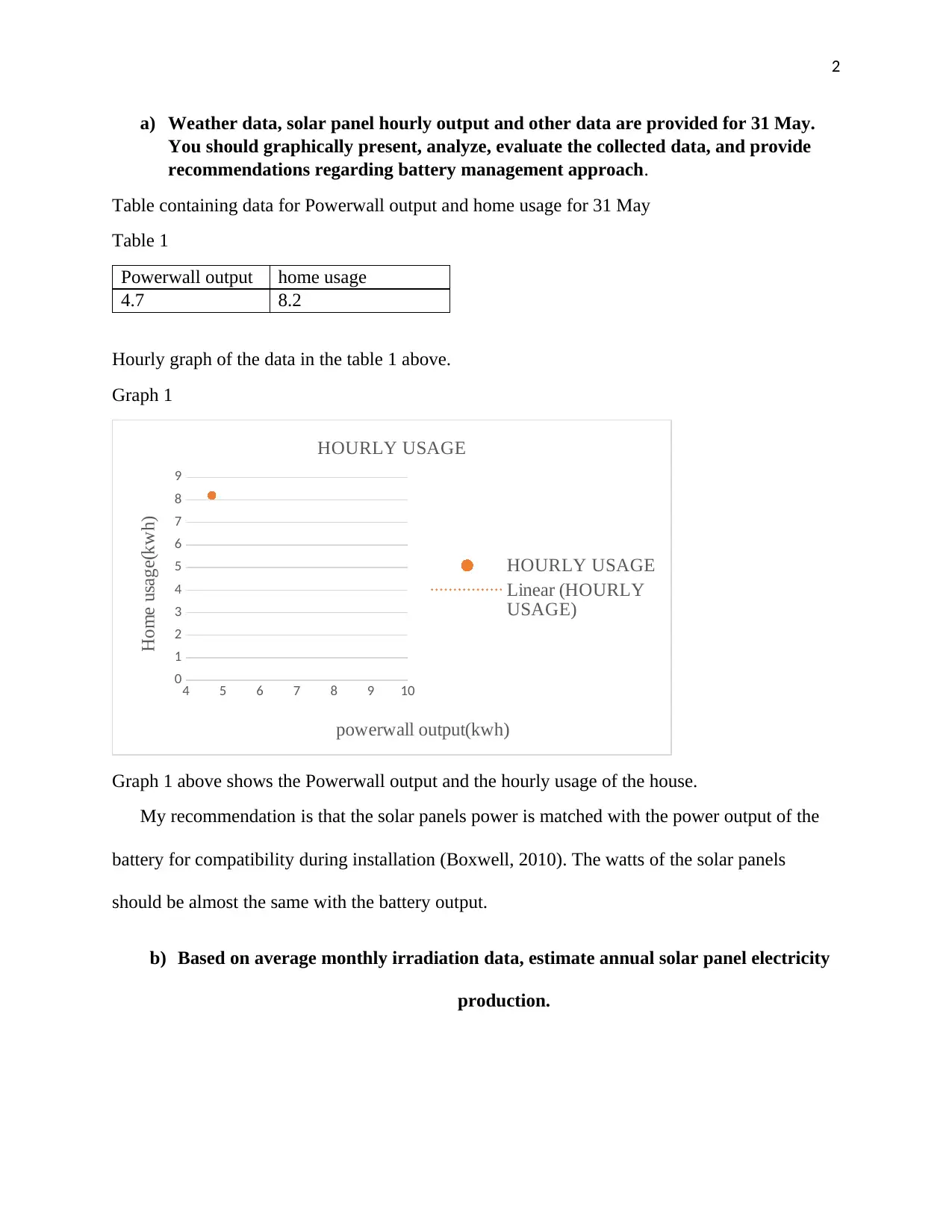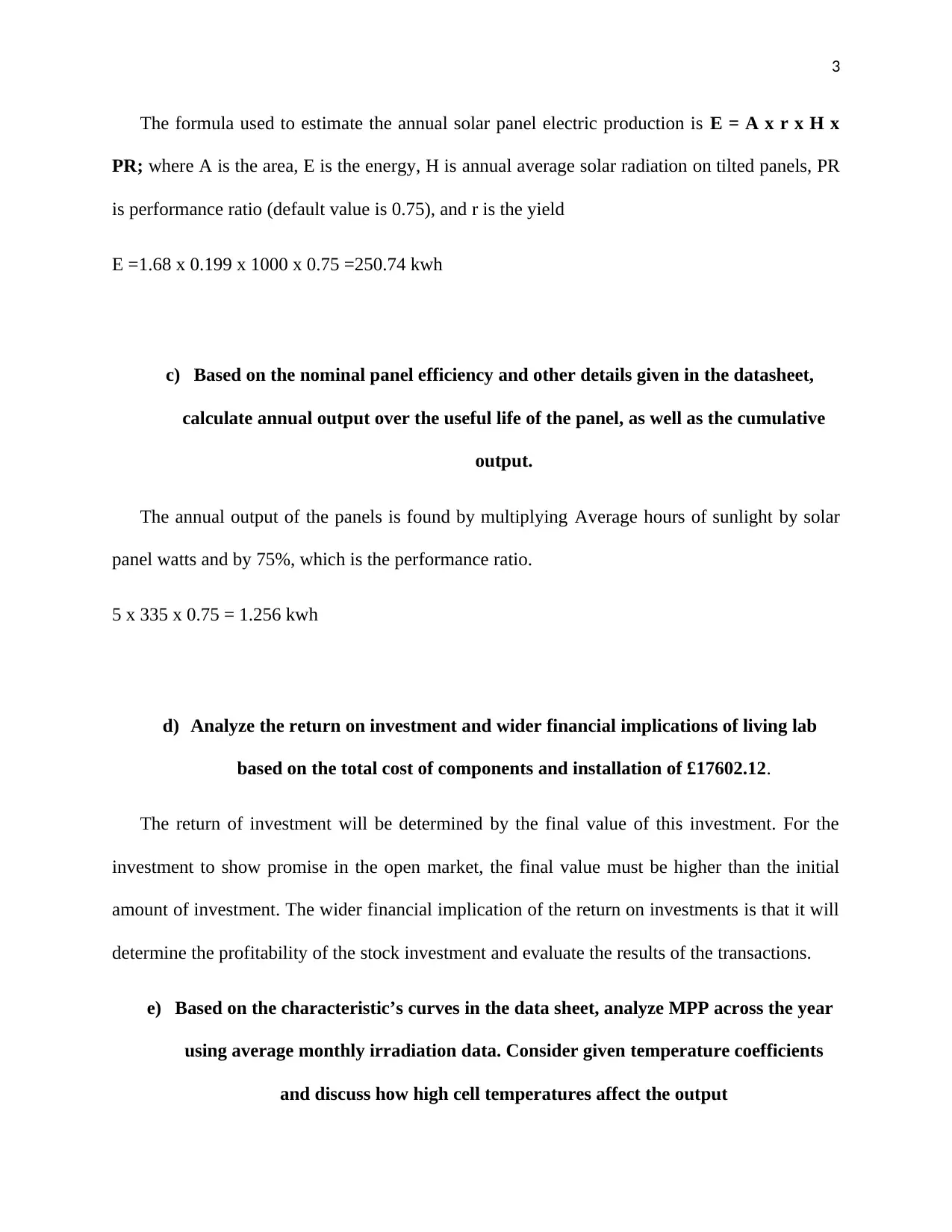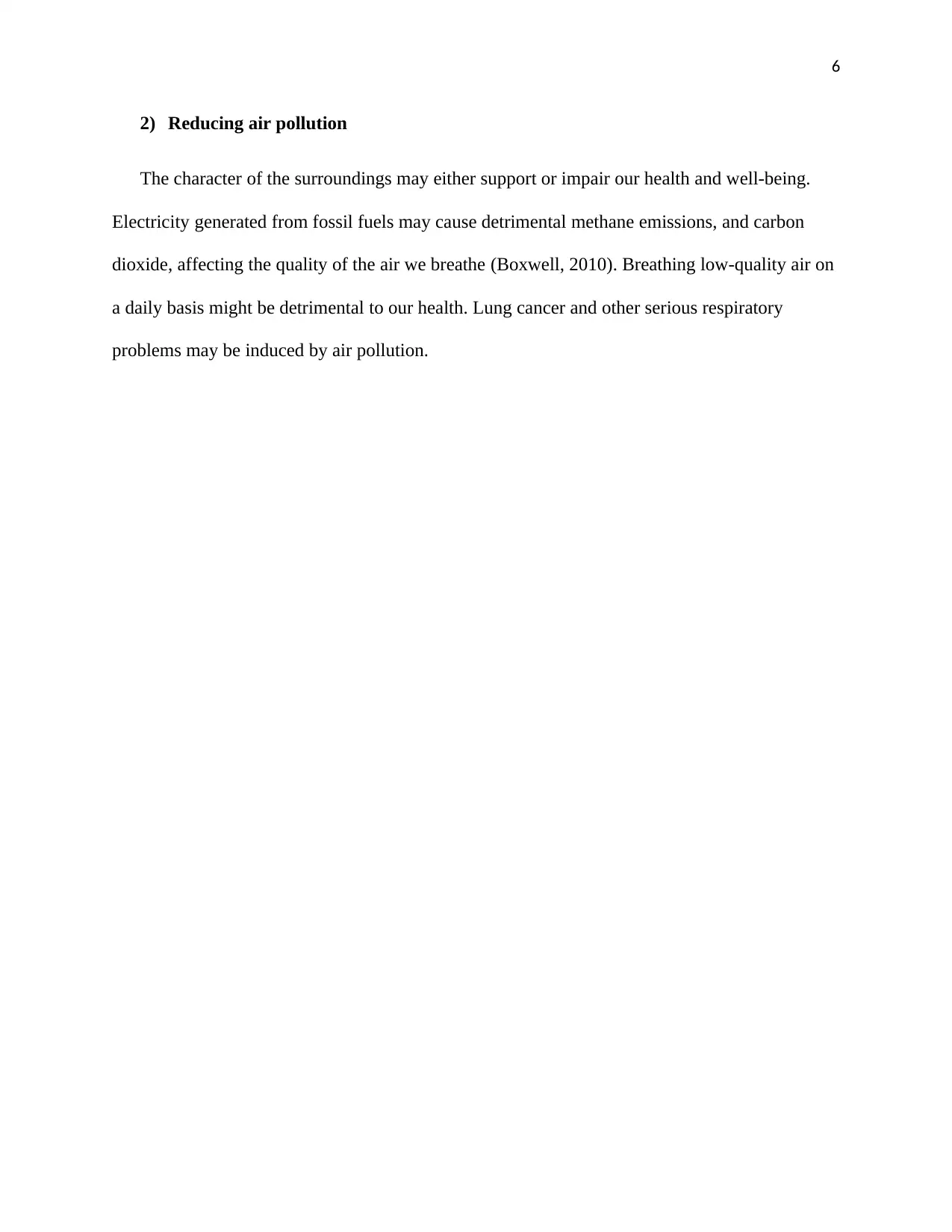Comprehensive Analysis: Solar Energy, Battery Management, and ROI
VerifiedAdded on 2022/01/20
|7
|1133
|195
Report
AI Summary
This report provides a comprehensive analysis of solar energy installation data, focusing on battery management strategies, solar panel performance, and environmental impact. It graphically presents and evaluates weather data, solar panel hourly output, and Powerwall usage to recommend optimal battery management approaches. The report estimates annual solar panel electricity production, analyzes the return on investment of a living lab, and discusses the effects of high cell temperatures on output. Furthermore, it examines the environmental effects associated with solar energy installations, including land use, toxic chemicals, recycling challenges, and water usage, while also highlighting the benefits of reduced greenhouse gas emissions and air pollution. Desklib offers a wealth of similar student-contributed assignments and study resources.

1
Student’s Name
School
Course Code
Course Title
Instructor’s Name
Due Date
Student’s Name
School
Course Code
Course Title
Instructor’s Name
Due Date
Paraphrase This Document
Need a fresh take? Get an instant paraphrase of this document with our AI Paraphraser

2
a) Weather data, solar panel hourly output and other data are provided for 31 May.
You should graphically present, analyze, evaluate the collected data, and provide
recommendations regarding battery management approach.
Table containing data for Powerwall output and home usage for 31 May
Table 1
Powerwall output home usage
4.7 8.2
Hourly graph of the data in the table 1 above.
Graph 1
4 5 6 7 8 9 10
0
1
2
3
4
5
6
7
8
9
HOURLY USAGE
HOURLY USAGE
Linear (HOURLY
USAGE)
powerwall output(kwh)
Home usage(kwh)
Graph 1 above shows the Powerwall output and the hourly usage of the house.
My recommendation is that the solar panels power is matched with the power output of the
battery for compatibility during installation (Boxwell, 2010). The watts of the solar panels
should be almost the same with the battery output.
b) Based on average monthly irradiation data, estimate annual solar panel electricity
production.
a) Weather data, solar panel hourly output and other data are provided for 31 May.
You should graphically present, analyze, evaluate the collected data, and provide
recommendations regarding battery management approach.
Table containing data for Powerwall output and home usage for 31 May
Table 1
Powerwall output home usage
4.7 8.2
Hourly graph of the data in the table 1 above.
Graph 1
4 5 6 7 8 9 10
0
1
2
3
4
5
6
7
8
9
HOURLY USAGE
HOURLY USAGE
Linear (HOURLY
USAGE)
powerwall output(kwh)
Home usage(kwh)
Graph 1 above shows the Powerwall output and the hourly usage of the house.
My recommendation is that the solar panels power is matched with the power output of the
battery for compatibility during installation (Boxwell, 2010). The watts of the solar panels
should be almost the same with the battery output.
b) Based on average monthly irradiation data, estimate annual solar panel electricity
production.

3
The formula used to estimate the annual solar panel electric production is E = A x r x H x
PR; where A is the area, E is the energy, H is annual average solar radiation on tilted panels, PR
is performance ratio (default value is 0.75), and r is the yield
E =1.68 x 0.199 x 1000 x 0.75 =250.74 kwh
c) Based on the nominal panel efficiency and other details given in the datasheet,
calculate annual output over the useful life of the panel, as well as the cumulative
output.
The annual output of the panels is found by multiplying Average hours of sunlight by solar
panel watts and by 75%, which is the performance ratio.
5 x 335 x 0.75 = 1.256 kwh
d) Analyze the return on investment and wider financial implications of living lab
based on the total cost of components and installation of £17602.12.
The return of investment will be determined by the final value of this investment. For the
investment to show promise in the open market, the final value must be higher than the initial
amount of investment. The wider financial implication of the return on investments is that it will
determine the profitability of the stock investment and evaluate the results of the transactions.
e) Based on the characteristic’s curves in the data sheet, analyze MPP across the year
using average monthly irradiation data. Consider given temperature coefficients
and discuss how high cell temperatures affect the output
The formula used to estimate the annual solar panel electric production is E = A x r x H x
PR; where A is the area, E is the energy, H is annual average solar radiation on tilted panels, PR
is performance ratio (default value is 0.75), and r is the yield
E =1.68 x 0.199 x 1000 x 0.75 =250.74 kwh
c) Based on the nominal panel efficiency and other details given in the datasheet,
calculate annual output over the useful life of the panel, as well as the cumulative
output.
The annual output of the panels is found by multiplying Average hours of sunlight by solar
panel watts and by 75%, which is the performance ratio.
5 x 335 x 0.75 = 1.256 kwh
d) Analyze the return on investment and wider financial implications of living lab
based on the total cost of components and installation of £17602.12.
The return of investment will be determined by the final value of this investment. For the
investment to show promise in the open market, the final value must be higher than the initial
amount of investment. The wider financial implication of the return on investments is that it will
determine the profitability of the stock investment and evaluate the results of the transactions.
e) Based on the characteristic’s curves in the data sheet, analyze MPP across the year
using average monthly irradiation data. Consider given temperature coefficients
and discuss how high cell temperatures affect the output
⊘ This is a preview!⊘
Do you want full access?
Subscribe today to unlock all pages.

Trusted by 1+ million students worldwide

4
The data sheet graph indicates that for lower resistive loads, the operating point will move
continually towards the maximum power point (MPP) of each curve as the radiation intensity
grows. For increasing resistive loads, on the other hand, the operating point will initially shift
towards the MPP and subsequently away from the MPP of each curve.
The cell's ambient temperature at STC is 25 0 C, whereas it's ambient temperature at NOCT
is 20 0 C. When the temperature is risen, the efficiency of the solar panel falls, implying that the
higher cell temperature limits the output of the solar panels.
f) Discuss environmental effects associated with this solar energy installation
solar energy has both positive and negative effects on the environment, some of the
negative effects include:
1) Land use
Solar panels on a large scale take up a lot of space, which might lead to habitat loss and
pollution. Solar farms that cover a large amount of land are likely to have a significant impact on
the ecology and wildlife in the region, particularly birds. Solar farms may have an impact on the
growth of nearby vegetation. Unlike wind energy, solar panels cannot share land with other uses.
Solar panels for domestic use on a small scale do not need a lot of land (Boxwell, 2010). On a
larger scale, however, the sheer size of the required area for the panels to generate energy is a
challenge. Furthermore, many people believe that utility-scale solar panels degrade the
appearance of the areas around them (Jha, 2013).
2) Toxic Chemicals
The data sheet graph indicates that for lower resistive loads, the operating point will move
continually towards the maximum power point (MPP) of each curve as the radiation intensity
grows. For increasing resistive loads, on the other hand, the operating point will initially shift
towards the MPP and subsequently away from the MPP of each curve.
The cell's ambient temperature at STC is 25 0 C, whereas it's ambient temperature at NOCT
is 20 0 C. When the temperature is risen, the efficiency of the solar panel falls, implying that the
higher cell temperature limits the output of the solar panels.
f) Discuss environmental effects associated with this solar energy installation
solar energy has both positive and negative effects on the environment, some of the
negative effects include:
1) Land use
Solar panels on a large scale take up a lot of space, which might lead to habitat loss and
pollution. Solar farms that cover a large amount of land are likely to have a significant impact on
the ecology and wildlife in the region, particularly birds. Solar farms may have an impact on the
growth of nearby vegetation. Unlike wind energy, solar panels cannot share land with other uses.
Solar panels for domestic use on a small scale do not need a lot of land (Boxwell, 2010). On a
larger scale, however, the sheer size of the required area for the panels to generate energy is a
challenge. Furthermore, many people believe that utility-scale solar panels degrade the
appearance of the areas around them (Jha, 2013).
2) Toxic Chemicals
Paraphrase This Document
Need a fresh take? Get an instant paraphrase of this document with our AI Paraphraser

5
The photovoltaic manufacturing process involves harmful toxins such as: 1,1,1-
trichloroethane, acetone, Hydrochloric acid, hydrogen fluoride, nitric acid, and Sulfuric acid. If
manufacturers don’t carefully adhere by the requirements, these compounds may cause
significant medical concerns, particularly to the production staff.
3) Recycling
The ultimate result of the solar panel cannot be recycled since it’s comprised of silicon.
Although the recycling of the solar panel incases it breaks has not been an issue, it will be a
concern in the approaching years since most people are moving to solar panels because they are
affordable and dependable in places with sunshine.
4) Water use
Using solar photovoltaic panels to generate energy is a water-intensive process. Even
though solar cells do not require water to create energy, the manufacturing process needs the use
of water. So, while the energy producing process does not require water, the water of solar
panels does (Boxwell, 2010). Power production accounts for a large share of total daily
freshwater withdrawals in some nations. Even if part of this water may be reused, an oversupply
of solar panels created in one region may impose a burden on local water supplies.
Some of the positive effects include:
1) Reducing greenhouse effect
Using solar energy instead of fossil fuels to create electricity would dramatically cut
greenhouse gas emissions, notably carbon dioxide (CO2). Greenhouse gases created by the
combustion of fossil fuels contribute to increasing global temperatures and climate change.
The photovoltaic manufacturing process involves harmful toxins such as: 1,1,1-
trichloroethane, acetone, Hydrochloric acid, hydrogen fluoride, nitric acid, and Sulfuric acid. If
manufacturers don’t carefully adhere by the requirements, these compounds may cause
significant medical concerns, particularly to the production staff.
3) Recycling
The ultimate result of the solar panel cannot be recycled since it’s comprised of silicon.
Although the recycling of the solar panel incases it breaks has not been an issue, it will be a
concern in the approaching years since most people are moving to solar panels because they are
affordable and dependable in places with sunshine.
4) Water use
Using solar photovoltaic panels to generate energy is a water-intensive process. Even
though solar cells do not require water to create energy, the manufacturing process needs the use
of water. So, while the energy producing process does not require water, the water of solar
panels does (Boxwell, 2010). Power production accounts for a large share of total daily
freshwater withdrawals in some nations. Even if part of this water may be reused, an oversupply
of solar panels created in one region may impose a burden on local water supplies.
Some of the positive effects include:
1) Reducing greenhouse effect
Using solar energy instead of fossil fuels to create electricity would dramatically cut
greenhouse gas emissions, notably carbon dioxide (CO2). Greenhouse gases created by the
combustion of fossil fuels contribute to increasing global temperatures and climate change.

6
2) Reducing air pollution
The character of the surroundings may either support or impair our health and well-being.
Electricity generated from fossil fuels may cause detrimental methane emissions, and carbon
dioxide, affecting the quality of the air we breathe (Boxwell, 2010). Breathing low-quality air on
a daily basis might be detrimental to our health. Lung cancer and other serious respiratory
problems may be induced by air pollution.
2) Reducing air pollution
The character of the surroundings may either support or impair our health and well-being.
Electricity generated from fossil fuels may cause detrimental methane emissions, and carbon
dioxide, affecting the quality of the air we breathe (Boxwell, 2010). Breathing low-quality air on
a daily basis might be detrimental to our health. Lung cancer and other serious respiratory
problems may be induced by air pollution.
⊘ This is a preview!⊘
Do you want full access?
Subscribe today to unlock all pages.

Trusted by 1+ million students worldwide

7
References
Boxwell, M. (2010, January 1). A simple,practical guide to solar energy-designing and installing
photovoltaic solar systems. Amazon. https://www.amazon.com/Solar-Electricity-
Handbook-2010-Photovoltaic/dp/0935754784
Jha, S. K. (2013). Application of Solar Photovoltaic System in Oman – Overview of Technology,
Opportunities and Challenges. International Journal of Renewable Energy Research, 3(2),
331–340. https://dergipark.org.tr/en/pub/ijrer/issue/16079/168241
References
Boxwell, M. (2010, January 1). A simple,practical guide to solar energy-designing and installing
photovoltaic solar systems. Amazon. https://www.amazon.com/Solar-Electricity-
Handbook-2010-Photovoltaic/dp/0935754784
Jha, S. K. (2013). Application of Solar Photovoltaic System in Oman – Overview of Technology,
Opportunities and Challenges. International Journal of Renewable Energy Research, 3(2),
331–340. https://dergipark.org.tr/en/pub/ijrer/issue/16079/168241
1 out of 7
Your All-in-One AI-Powered Toolkit for Academic Success.
+13062052269
info@desklib.com
Available 24*7 on WhatsApp / Email
![[object Object]](/_next/static/media/star-bottom.7253800d.svg)
Unlock your academic potential
Copyright © 2020–2025 A2Z Services. All Rights Reserved. Developed and managed by ZUCOL.